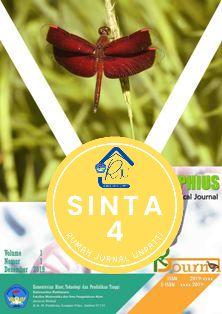Diversity of Gastropods in the Intertidal Zone of Tanjung Air Panas Beach, Tulehu Village, Central Maluku Regency, Indonesia
Abstract
Research on the diversity of gastropods in the intertidal area of Tanjung Air Panas Beach, Tulehu Village, Central Maluku Regency was conducted in November 2024. Gastropod samples were collected in 60 quadrants on 5 belt transects. All individuals obtained were identified to the species level and the number of individuals was counted. The results of the study showed that gastropods in the intertidal area of Tanjung Air Panas Beach, Tulehu Village consisted of 9 species belonging to 1 subclass i.e. Caenogastropoda, 3 orders, namely Caenogastropoda, Littorinimorpha and Neogastropoda, 7 families and 8 genera. Nassarius globosus had the highest occurrence frequency and was found in all transects and all quadrants (100%), followed by Conus ebraeus which was found in 6 quadrants (10%) and then Canarium microurceus which was found in 4 quadrants (6.67%). The highest density is owned by N. globosus with 2,633 ind./m2 (87.78%) then followed by C. ebraeus with 0.117 ind./m2 (3.89%) and C. microurceus with 0.100 ind./m2 (3.33%). The Shannon diversity index (H’), Simpson dominance index (D) and Shannon uniformity index (E) are 0.59, 0.77 and 0.27, respectively. Based on the three indices, it can be concluded that the gastropod community in the intertidal area of Tanjung Air Panas Beach, Tulehu Village has low diversity and uniformity with high dominance.
Downloads
Copyright (c) 2025 Jesaja Ajub Pattikawa, Mahriyana Hulopi, Prulley Annette Uneputty, Laura Siahainenia, Ilfayeni Salsabillah Tawainella

This work is licensed under a Creative Commons Attribution-NonCommercial-ShareAlike 4.0 International License.
Authors who propose a manuscript and have it approved for publication know that the manuscript will be registered and become part of the RPBJ. Authors and readers understand that this journal is open and all its contents can be accessed freely, provided that RPBJ is still listed as the source of information. The hope is that this journal can become a vehicle for exchange and scientific knowledge for society and the scientific community, especially in the field of Biology and other branches of science.









